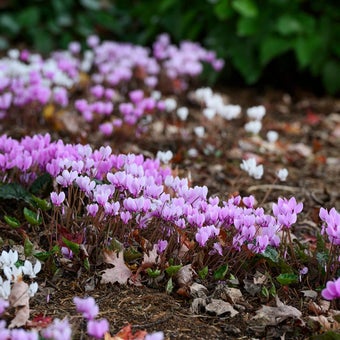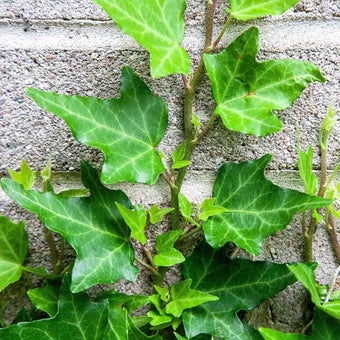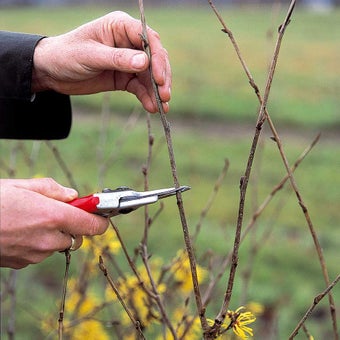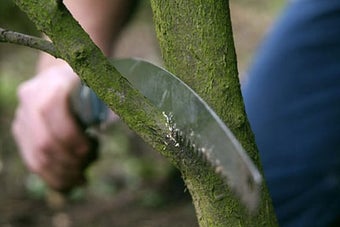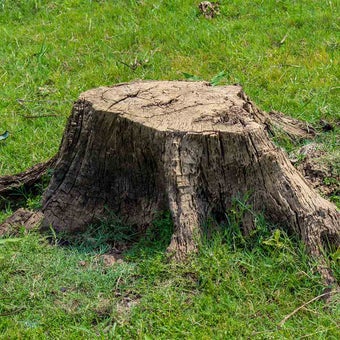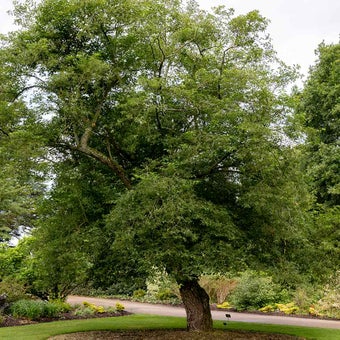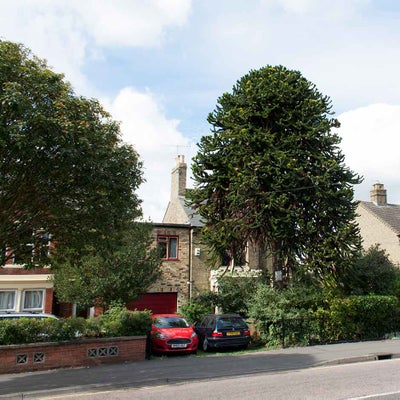
Quick facts
Most trees cause no damage
Tree roots spread up to three times the height of the tree
Modern buildings are seldom affected
Shrinkable clay soils are most at risk
Subsidence is worst in dry years
What is the problem with trees and buildings?
As well as subsidence and structural damage by tree roots, blocked drains and lifted paving may also be a problem. Understanding the factors involved in tree damage to buildings, including soil type and depth of foundations, will help both tree and house owners determine what action to take and when to get professional help.
Structural damage caused by subsidence
- This is generally only a problem on shrinkable clay soils. Buildings up to four storeys constructed before the 1950s are most at risk, as they frequently have comparatively shallow foundations
Drain damage
- Roots may enter and block drains. If the drain leaks, it can lead to the formation of cavities where water flows into the soil. Older drains with poor seals and rigid joints are most susceptible
Physical damage
- Branches can cause damage to roofs and guttering. Suckers and expanding roots can lift paving and lightweight structures, such as garages and sheds, but are incapable of lifting heavier structures
Cause and control
Just how can tree roots cause problems?
- If there is a shrinkable clay soil, during prolonged periods of drought, trees can dry out the soil below the foundations causing the soil to shrink. This shrinking usually reaches a maximum in late summer, and is termed 'seasonal soil moisture deficit' because the soil normally has chance to rewet after winter rains. The movement in the soil can result in subsidence of the foundations and structural cracking. Cracks are most likely to develop around windows and doors (note: 5-10mm of movement is usually needed before cracks develop). Less commonly, a permanent soil moisture deficit can develop where the soil continues to get drier at depth year-on-year. In rare cases tree removal on such soils can lead to heave (i.e. upward movement of the foundations due to clay expansion rather than shrinkage)
- Tree roots are unlikely to directly penetrate sound footings
- Tree roots will proliferate where water is available, and this is what causes them to grow into drains. If the drains are watertight, then tree roots will not generally trouble them
How can damage be prevented or minimised?
Careful selection of trees for a site where buildings are close by is needed, but this does not mean large trees cannot be planted in a built-up area. The loss of street trees and garden trees in our towns and cities due to an overly cautious approach by insurers and councils is itself a worry, as urban areas need trees to maintain a healthy environment.
It is hard to predict which trees will cause damage because even where conditions mean the risk is high, only a very small proportion of trees will go on to cause subsidence. Risk prediction systems are largely fallible so it is normally best to wait until a tree becomes a real risk (i.e. causes damage) before taking action.
Things to bear in mind if you're concerned about trees near houses and other buildings:
- It must be noted that many trees grow near buildings and, in most cases, these will not cause any damage
- However, sometimes trees growing near buildings can cause major problems, especially after a long period of dry weather
- Subsidence is the main problem posed by trees, but there are also the physical threats caused by falling limbs or structural failure of the main trunk
- If you own a substantial tree near a building or public highway, it is well worth having it professionally surveyed every few years to assess its overall health and to determine any pruning or felling requirements. Ensure that you keep these reports in a safe place, as they may be useful in any negotiations with insurance companies or public bodies
Tree legislation
A tree is the property and responsibility of the land owner, who may be liable for any damage caused. Always check with the Local Planning Authority whether a Tree Preservation Order is in place before working on a tree.
Worried about trees and damage?
Trees can cause concern for both tree owners and house owners. See below for Frequently Asked Questions.
Tree owners – Frequently Asked Questions
Is my tree likely to cause a problem to buildings?
This depends on a number of factors. Gardens on non-clay soils (e.g. chalk or sand) are very unlikely to encounter problems with trees damaging buildings. However, if you are on a heavy clay soil, there is an increased risk. In addition, the larger the tree, the higher the ‘water uptake’ for that species of tree and the closer the tree is to buildings, the higher the risk too.
How to I find out what the ‘water uptake’ is of my tree?
The book Tree Root Damage to Buildings by Biddle P.G (see Further reading) contains a useful table of tree water uptake, listing trees with the lowest demand (posing the least risk) to the highest demand (posing the most risk). Low water demand treesinclude; [broadleaved] Catalpa, Corylus, Liquidambar, Liriodendron, Magnolia, Morus, Sambucus, [conifers] Abies, Araucaria, Ginkgo, Larix, Piceaand Pinus. High water demand trees include; [broadleaved] Eucalyptus, Populus, Quercus, Salix, [conifers] Cupressus, Chamaecyparis and x Cuprocyparis. Quercus (oak) accounts for the highest number of subsidence cases in the UK. Other species generally have an intermediate water demand.
How far from a tree could problems to buildings be caused?
Tree to damage distance will depend on the type and size of tree. Indications of these distances for some tree species can be found in the book Tree Roots and Buildings by Cutler, D F and Richardson (see Further reading). As a general rule, for high water demand species, expect soil drying influence to extend outwards from the tree to a distance equivalent to the height of the tree. For intermediate and low water demand species influence is unlikely to extend more than half the tree’s height. But remember, other factors contribute to damage occurring and most trees never cause problems for buildings.
Our tree has been identified as contributing to subsidence in a neighbouring property. We would prefer not to lose the tree. Will pruning be an effective solution?
When a specific tree has been found to be the main cause of subsidence having it felled is usually the most permanent solution. However, tree reduction can reduce the amplitude of movement, so could be considered as a way to manage the problem. To be effective, pruning needs to reduce the crown volume of the tree by at least 70 percent, and be repeated on a regular basis such as every three years. Crown thinning (as opposed to crown reduction) has been found to be ineffective at reducing transpiration rates. It should also be noted that in cases of permanent deficit (i.e. London clay soils where low permeability leads to deeper permanent drying), felling the tree poses a risk of progressive heave. If there is a risk of significant heave, the only effective solution may be to have the property underpinned (see FAQs for Property owners section).
We have been informed our tree is causing subsidence to some newly-built houses. Surely we’re not liable for damage, as the tree was there before the development. Or are we?
Tree owners are liable for full costs of repairs if a tree is found to be ‘materially contributing’ to that damage. It is no defence to claim the following: the tree was there before the building; the foundations were inadequate; the tree is more valuable than the building; or that as tree owner you were not aware of the risk. Potential defences include trees that have been subject to appropriate management; the presence of clay soil was not reasonably foreseeable (i.e. not marked on a geological survey map); or that there was no remedial action available to prevent the damage such as in cases of heave on persistent deficit soils).
I have just been notified that our tree is causing damage. Can I ignore this? What do I need to do?
Once notified, the tree owner is obliged to do something about it. There are three steps:
- Notify your content insurers for third party liability
- Interpret available reports (which should be provided at the same time as notification was given – if not, request all reports as the tree owner is entitled to full disclosure)
- If appropriate, take prompt remedial action such as tree felling or reduction
If a tree has a Tree Preservation Order (TPO) or is in a Conservation Area, does this mean it cannot be felled even if it is damaging buildings?
No. Trees that are covered by some sort of protection such as a TPO can still be required to be felled if they are found to be damaging buildings. However, application for work on such trees usually requires appropriate monitoring and other investigations (see question 'How is responsibility for subsidence determined?' under Property owners FAQ below) and reports to be made available.
Can climbers, wall shrubs and hedges also cause damage?
Yes, potentially. Large wall shrubs, most notably Pyracantha and Wisteria, can caused localised subsidence. Level monitoring will demonstrate which vegetation is most likely to be involved. Tall hedges can also contribute to soil drying so it is advisable to maintain hedges in a subsidence prone area to a height equivalent to the distance of the hedge to the building.
Will putting in root barriers help ensure my tree doesn’t cause damage to buildings?
In theory, yes, but in practise it is usually not feasible to install tree root barriers to sufficient depth. There is also the risk that tree roots will simply ‘follow’ and grow under a barrier since the trenching that is required to fit a barrier also introduces air and water, making an attractive growing environment to roots.
We have old drains and trees growing near to them. Do I need to do anything to prevent the roots blocking the drains?
If the drains are sound (i.e. do not leak) then there should not be a problem and no action is necessary. However, if the old drains leak, this gives opportunity for roots to enter them and potentially cause blockages. So, there are three options. One is to remove the trees but this should only be considered as a last resort. The second is to line the leaky drains with a resin-soaked liner which can prevent roots getting in. The third, and most permanent solution, is to have the old unsound drains replaced with new polypropylene drainage pipes which resist damage from tree roots.
Our patio paving is being lifted by roots from our cherry tree. Can we stop this? Does it mean the roots are also damaging our house?
There is no direct link between damage to non-load-bearing structures such as paving and load-bearing structures such as houses. Most lifting of surface structures such as drives and patios occurs within a 1m radius of a tree’s trunk, corresponding to where the buttress of the trunk base forms. Thus it is advisable not to pave or tarmac within this area (which is also beneficial to the tree). Some tree species, notably Prunus (cherries), have roots that grow very close to the soil surface, making them more likely to lift paving. If damage is localised and at some distance to the tree, the offending root could be cut off, a root barrier fitted to prevent roots growing back into this area and repairs to patios or drives made. Large roots close to the tree should not be cut as these may kill or destabilise the tree.
Property owners – Frequently Asked Questions
I understand my house is at a higher risk of damage from trees if I am on a clay soil. How can I find out what my underlying soil type is?
For properties in Great Britain, the Geology of Britain Viewer map lists soil type. A town or postcode can be entered into the ‘Go to location’ field. Clicking on the map reveals the soil type. Properties in areas with clay or mudstone in the bedrock, especially ‘London clay formation’, may be at risk.
My house was built in 1980. Is it at risk of subsidence?
Building Regulations came in during the 1970s so most houses built after 1980 will have deeper footings than those built earlier, making them much less likely to experience damage from nearby trees.
We are planning on building a single story extension at the back of our house but there are lots of big trees in neighbouring gardens. Should I worry?
Extensions are more vulnerable to subsidence so if you are on a clay soil seek professional advice from a structural engineer.
I am worried about the large conifers in my neighbour’s garden and think they should fell them. Can I insist on this?
No, not without evidence of a) damage to your house and b) that it is their tree or trees that are to blame. If the conifers are a hedge they may qualify for some reduction under the High Hedges Act.
I have been digging near to my house and found roots that I am fairly certain come from my neighbour’s tree. How do I identify them and are they going to damage my house?
Firstly, tree roots are not strong enough to physically push buildings around, so finding them close to houses isn’t necessarily a problem. However, if you have also started to notice cracks in house walls appearing, especially on the same side of the house as the tree roots, it is a strong possibility the tree is a factor in causing the damage. See questions below for what to do. Roots can be identified by specialist firms using microscopic examination. However, this is not the most reliable method for determining if a given tree is to blame; level monitoring is much better.
Root identification: Please note, the RHS is not able to offer a root identification service.
Some cracks have appeared in one of our external house walls. Is the oak tree at the end of our garden to blame?
If cracks in buildings appear in late summer, the cause is most likely vegetation related – i.e. trees and other larger plantings – and mature oak trees have a very high water demand so it could well be a key factor if it is growing on the same side of the house where the cracks are most noticeable. Cracks appearing at other times of the year are more likely due to different factors such as an unstable slope, settling of new builds, collapse of soil structure after flooding, leaky drains on sandy soils, sink holes or earthquakes.
Some cracks have appeared in our house wall. They are getting worse and I think my neighbour’s tree may be to blame. What should I do?
The first step to take is:
- Notify your building insurers that damage to your house has occurred
- Your insurers will then investigate to determine the cause of the damage (usually through a structural engineer and monitoring specialist)
- If a tree has been found to be causing the damage and it is a tree you own, your insurer will inform you of remedial action (such as having the tree felled) required
- If a tree has been found to be causing the damage and the tree is in a neighbouring garden or land, your insurer will notify the owner of the tree and indicate what remedial action (such as having the tree felled) is required
How is responsibility for subsidence determined?
Usually by one or both of the following ways:
- Soil investigation. Bore holes may be made to establish if there is a soil moisture deficit, but these are complex to interpret, and are only likely to indicate vegetation related deficits if taken at the end of summer. They are not the most reliable method. Roots may be taken for identification
- Crack and level monitoring (building interaction). Specialist companies set up markers around the walls of a house to monitor any changes in level of the building (i.e. which part of a building is moving (up which indicates heave or down which indicates subsidence). This is a more reliable method than soil investigation. Crack monitoring is also useful in showing crack pattern but should only be done in conjunction with level monitoring because it is less reliable at showing up vegetation-related subsidence
We’ve had a report which says the subsidence is caused by seasonal deficit. What does this mean?
Seasonal deficit is where the soil dries each summer but re-wets after rains each winter. The depth of drying and soil permeability are critical, but in most cases soil drying is seasonal. In cases of seasonal deficit, the best solution is to control the cause of the soil drying. Having the tree felled will prevent further water uptake; having it reduced or root-pruned will reduce the amplitude of movement.
Permanent deficit is where the soil has low permeability (typical of London clay soils), so rains never fully rewet the full depth of soil, thus leading to deeper permanent drying. In cases of permanent deficit, underpinning the house may be required with full anti-heave precautions. The good news is that cases of heave in the UK are now much less common as most houses at risk have already been underpinned.
Further reading
The following books and publications make useful reading;
Tree Root Damage to Buildings by Biddle P.G (Willowmead Publishing 1998, Oxford ISBN 095330860X)
The Influence of Trees on House Foundations on Clay Soils (Building Research Establishment Digest 298)
Tree Roots and Buildings by Cutler, D F and Richardson, I B K (Longman Scientific and Technical 1989, ISBN 0582034108)
Precautions to Take When Building Near Trees (The National Housebuilders Standards 1992)
Has Your House Got Cracks? by Freeman, Littlejohn & Driscoll (Thomas Telford Ltd. 1994, ISBN 0727719963)
Some of these books are made available through the RHS Lindley Library.





